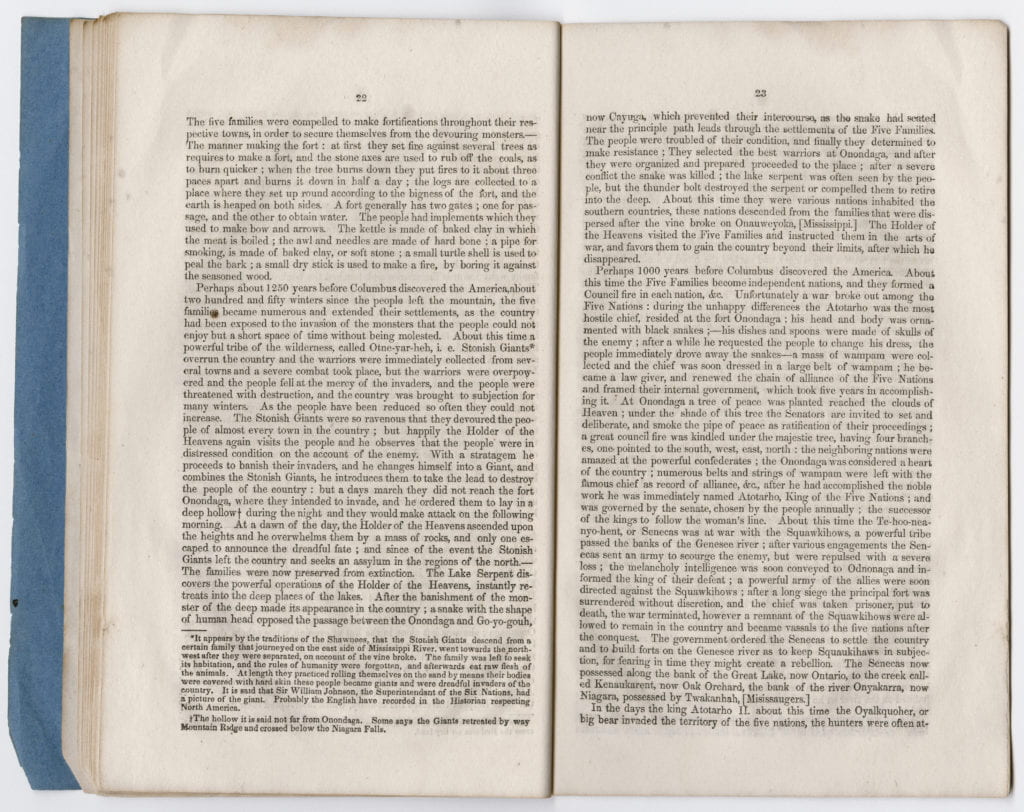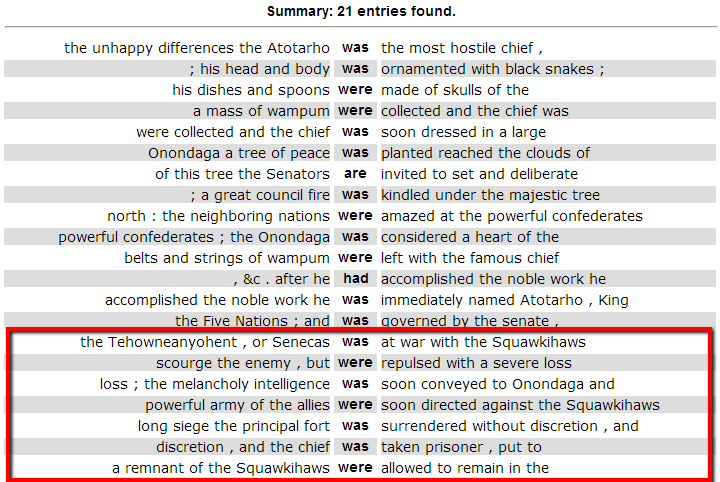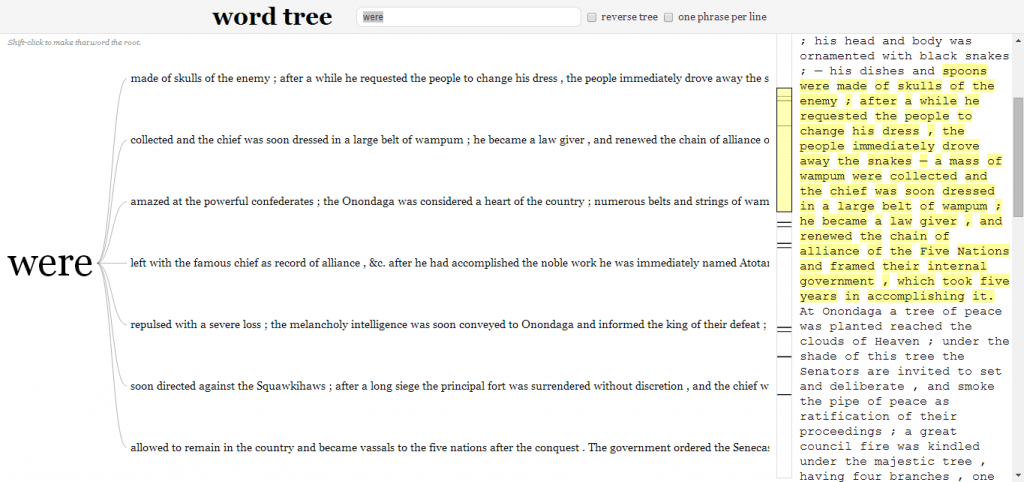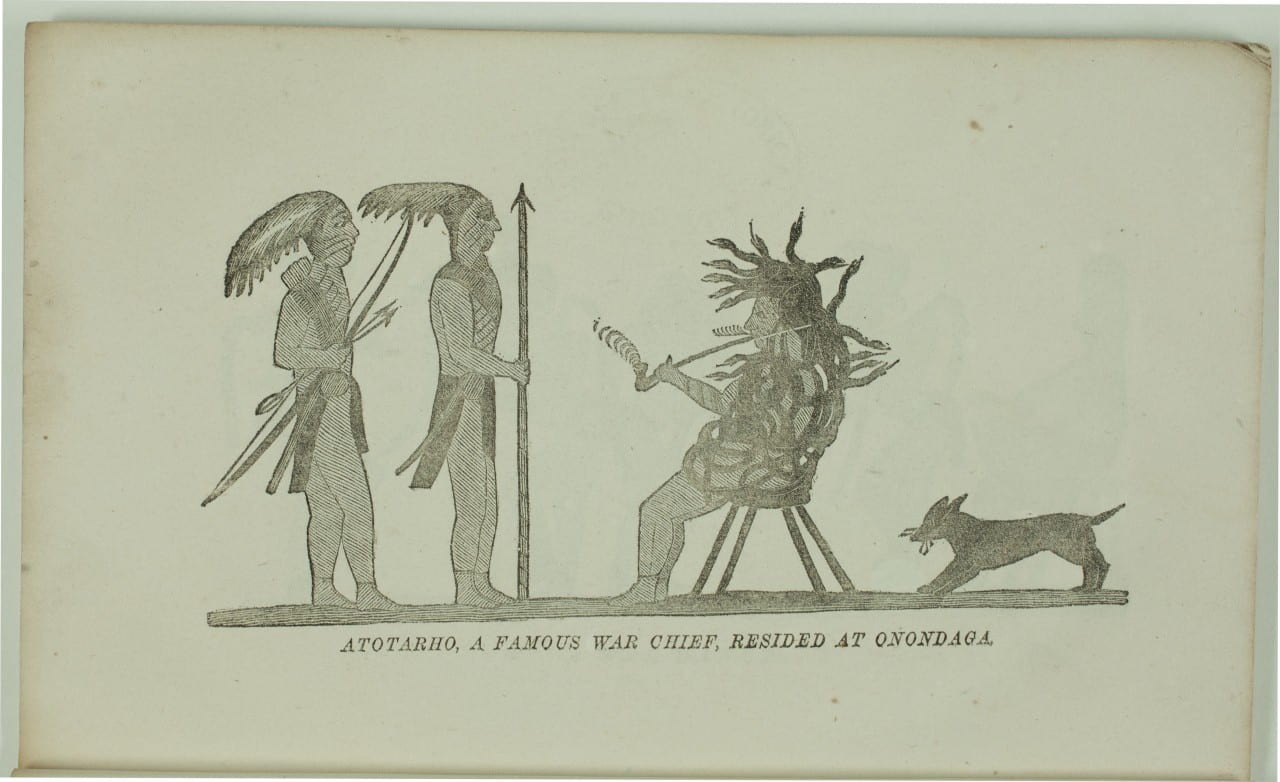Project Description
This is the summary for my digital humanities project called The Political Implications of the Passive Voice. To see what went into making it, visit my process page.
For my project as part of our student authored website, I created an HTML markup of a passage from the Tuscaroran author David Cusick’s Sketches of Ancient History of the Six Nations (1827). I used this digitally marked up passage from a book in Amherst College’s Kim-Wait Eisenberg Native American book collection to create a short and informal essay made up of my observation from the HTML markup and a few related text visualizations. While smaller in its initial scope, this work serves as proof of concept for future students’ literary inquiries through this or a similar type of analysis.
Background
Context: David Cusick’s Sketches of Ancient History of the Six Nations is one of if not the first Native histories written by a Native American author. In less than 50 pages, Cusick gives a historical and mythological account of the creation of the Iroquois (Haudenosaunee) people and the formation of the Iroquois Confederacy. He starts with the formation of the Great Island, Now North America, on the back of the ‘large turtle’ and moves to describe the settlement of the first people in America, ancestors of the Iroquois. The bulk of his writing goes on to detail the establishment of the five and later six tribes (Mohawk, Oneida, Onondaga, Cayuga, Seneca, and Tuscarora (joined later)) that make up the Confederacy as well as their many battles against mythical and tribal enemies. The book was popular in its time. Cusick republished the book in 1828 with more text and his own illustrations. Two more editions of Sketches ran in 1848 and 1892. Amherst College Archives owns a copy of 1848 edition.
Interests: Of the nearly 1400 works by Native American authors that make up the KWE collection, I quickly developed a particular interest in Sketches. I was especially drawn in by the amount of geographic and geologic details throughout the book. With my initial project ideas, I wanted to explore the significance of place within this creation story through some sort of digital mapping. For reasons I detail in my process page I eventually shifted my focus to exploring patterns in Cusick’s language through text analysis tools. As I began working on my final project, I wanted to know what patterns or structures existed in Cusick’s text and how the implications of those patterns could contribute to scholarly conversations around this work.
Methods: To see what could come of these questions, I honed in on the passage you see here for a few reasons. For the sake of time, I needed to work with a smaller set of data (words), so one passage would do. This passage (hereafter the formation passage) was also significant because this is where Cusick details the actual formation of the Iroquois Confederacy. This seemed to be a crucial historical moment to record. And yet he only gives this one long paragraph before moving on to recount in greater detail the reign of the Atotarho after Atotarho I brought the tribes together. Why so little attention for such a big moment? How does he structure what he does write?

I got started by tagging certain parts of speech through XML (meaning I labeled the text so that when the computer read “nations,” it understood it as a plural noun). From there, with the help of Sarah Walden, I was able to get an HTML markup of the formation passage to better observe some trends in the writing (so when the computer read “nations” tagged as a plural noun, it would display it as blue onscreen). Once I picked out some interesting details, I used other text visualizations (programs or apps that manipulate and display texts for the user to study in ways that would be too difficult or less informative if done by hand) to highlight them as further evidence of claims I would make. I did this digitally (and not with a highlighter) because I wanted to have the possibility of working with more text; I or anyone else wishing to work with all of Sketches or would certainly need the help of a computer to handle the 13000 plus words. I also wasn’t sure what I was going to find before I started tagging. I wound up analyzing the text visually after marking it, but given more time and expertise, there were other more data and statistically driven approaches that would have led to similar conversations.
[Key: Noun/Pronouns, Adjectives, Adverbs, Active Verbs, Passive Verbs. Spelling errors or inconsistencies have been corrected from original text for better results from text analysis tools. Grammar, punctuation have stayed the same as original.]
Perhaps 1000 years before Columbus discovered the America. About this time the Five Families become independent nations, and they formed a Council fire in each nation , & Unfortunately a war broke out among the Five Nations : during the unhappy differences the Atotarho was the most hostile chief, resided at the fort Onondaga ; his head and body was ornamented with black snakes ;— his dishes and spoons were made of skulls of the enemy ; after a while he requested the people to change his dress , the people immediately drove away the snakes — a mass of wampum were collected and the chief was soon dressed in a large belt of wampum ; he became a law giver, and renewed the chain of alliance of the Five Nations and framed their internal government, which took five years in accomplishing it. At Onondaga a tree of peace was planted reached the clouds of Heaven ; under the shade of this tree the Senators are invited to set and deliberate , and smoke the pipe of peace as ratification of their proceedings ; a great council fire was kindled under the majestic tree, having four branches, one pointed to the south, west, east, north : the neighboring nations were amazed at the powerful confederates ; the Onondaga was considered a heart of the country ; numerous belts and strings of wampum were left with the famous chief as record of alliance, &c., after he had accomplished the noble work he was immediately named Atotarho, King of the Five Nations ; and was governed by the senate, chosen by the people annually ; the successor of the kings to follow the woman’s line. About this time the Tehowneanyohent, or Senecas was at war with the Squawkihaws, a powerful tribe passed the banks of the Genesee river ; after various engagements the Senecas sent an army to scourge the enemy, but were repulsed with a severe loss ; the melancholy intelligence was soon conveyed to Onondaga and informed the king of their defeat ; a powerful army of the allies were soon directed against the Squawkihaws ; after a long siege the principal fort was surrendered without discretion, and the chief was taken prisoner, put to death, the war terminated, however a remnant of the Squawkihaws were allowed to remain in the country and became vassals to the five nations after the conquest. The government ordered the Senecas to settle the country and to build forts on the Genesee river as to keep Squawkihaws in subjection, for fearing in time they might create a rebellion. The Senecas now possessed along the bank of the Great Lake, now Ontario, to the creek called Kenaukarent, now Oak Orchard, the bank of the river Onyakarra, now Niagara, possessed by Twakanhah, [Misissaugers .] (p 22-23)
Initial Observations
One of the first things I noticed from this color coded passage was the amount of nouns and verbs compared to the amount of descriptive words. Without doing any counting by hand or with a machine, I saw that Cusick is a man of few descriptive words. While this is just one passage, my difficulty with extracting descriptive words from his use of geographical features and place names made me think this might be a larger pattern in his writing.
Looking a little closer at his verbs, I saw that the verbs that Cusick did use carried a lot of weight. The last sentence of the formation passage is a good example of what I mean- it contains a string of place names highlighted in blue that are linked by two instances of the active voice verb possessed. Highlighting the words in this context shows one small example of how Cusick emphasized Native Americans’ right to their land, land in this sentence that is book ended by two tribes.
I’ve noted these few- can you find other patterns or interesting details?
Analysis Example: Passive Voice
To take an example a bit further, I wanted to look more at passive verbs. Early on in studying the color coded paragraph, I saw that Cusick used the passive voice a good amount (his head and body was ornamented with black snakes v.s. black snakes ornamented his head and body).This was not surprising because, in my experience reading Sketches, the passive voice crops up a lot in the rest of the book. In my opinion, some of the difficulty with reading Sketches comes from how much Cusick used the passive voice. If you’ve taken an English or writing class before, you certainly know why this can be a dangerous- it leads to weak language; it adds unnecessary words that become hard to follow; the real agent behind the action of the verb gets lost or there may be little action at all.
So why the interest here? Because Cusick might be doing more with it than you (and certainly I) might think.
In short, this project made me think that, in certain moments, Cusick used the passive voice to distance the Iroquoian identity he was creating from their warring and violence against other tribes. This claim is in conversation with Susan Kalter’s “Finding a Place for David Cusick in Native American Literary History.” She argues that by writing Sketches, Cusick sought to combat discourse of savagism that American society created pre and post Removal (9). Using only the words from the formation passage, the list and word tree of words below certainly speak more to this idea of combating savagism.
Figure 1 is from the concordance tool I used to isolate instances of the passive voice from the formation passage, instances which the tool extracted when I limited its search of the text to auxiliary verbs like was, were, etc. Figure 2 is from a wordtree that I used to display more context for instances of the word “were.” The tools complimented each other because I was able to get broad and detailed context for uses of the passive voice.
The framed portion of the list and the bottom branches of the tree work together to show particularly interesting cases where Cusick writes in the passive voice, obscuring the agent of the sentence (in one case, the Senecas) from the violent action that was done to the Squawkihaws. He could have said the Senecas killed the rival chief and and took over their fort/land. But he doesn’t. It just sort of happens. At the same time, he doesn’t or cannot leave that part of the history out and so seems to find a way of doing so in a positive light.


Granted, this is a passage of less than 500 words in a document of over 13000- how much can this small section really help us say anything about Cusick’s text on a wider scale? Well, consider this: the ratios derived from the combined raw frequency of ‘was’ and ‘were’ (as a simple, admittedly imprecise way of capturing more instances of the passive voice) compared to other words was higher in the formation passage (0.042) than in the text as a whole (0.034). Even if this fast calculation done using another concordance tool can’t reveal the distribution of the passive voice, it still makes me think there’s something unique about the language of the formation passage.
To test if Cusick did use the passive voice consistently in this way, I would need to find a way to define and search for the various constructions of the passive voice used in English across the text. That sounds a bit challenging for me now, but the work may be worth doing for someone. This idea leaves me with questions that warrant more exploration: If what I found and argue is plausible in Cusick’s writing, is it similar in other Native American writers at the time, or writers in general? What does this linguistic choice mean for how we understand the cultural and political environment Cusick entered when he wrote Sketches?
Closing Thoughts
Remember where this all comes from: a recent college grad with a summer’s worth of research. Remember as well that this whole write-up happened because of the marked up text I created. Going into this project, I never would’ve picked up on what I did or thought I would wind up writing about the political implications of the passive voice. But that was what happened.
My prototype digital humanities project in text analysis has only cracked the surface of what I feel could be its real value. If I had more time or if this project were to go through a second stage, I would first want to work with more text. Had I more knowledge and time to try out different programs that allow you to tag different parts of speech, I would’ve had more words and possible patterns to pull out. Working with a program that tags for you would have made comparing different texts a possibility.
In particular, I would’ve liked to compare similar scenes between Sketches and Elias Johnson’s Legends, Traditions and Laws of the Iroquois, and History of the Tuscarora Indians (another 19th century Iroquoian book that has a creation story written by a Tuscaroran author). In its ideal form, I imagine the whole text from Cusick’s Sketches being digitally tagged and usable and more interactive so that others could search and highlight parts of speech according to their research needs. As it stands, this project demonstrates the type of scholarly engagement possible through digital means.
Please send any corrections or questions to Digital Programs at libdig@amherst.edu
